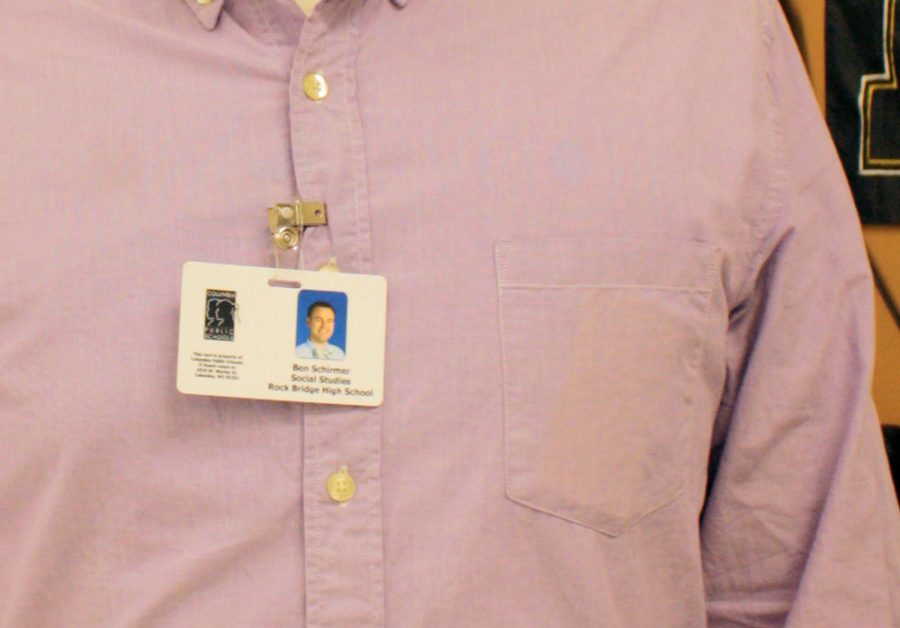Following the recently installed buzz-in system, CPS has now issued for teachers and students to be given proximity cards. Staff members will use these cards to enter the building, where the system will “sense” the card when in close proximity and open the door hands free.
RBHS assistant principal Brian Gaub said the cards are similar to the size of a drivers license and can fit in a wallet or worn on a lanyard with ease. The idea behind the installment is to provide teachers easier and more convenient access to the school.
“The proximity card is kind of the next generation,” Gaub said. “It replaces the key and will also disarm the alarm, like if teachers are coming in on the weekend, it’ll manage the alarm for them.”
Eventually the plan is to give students their own proximity cards, which he said is the step that the administration is most looking forward to. There is a much larger scale of students compared to teachers, so preparing the cards for them results in a higher cost. Gaub said this is why the cards students will carry are not currently ready for use.
The proximity cards are ordered at the district level, so they are going to be made not only for RBHS, but for Hickman High School and the CACC. Gaub believes this is what contributes to the cost and delay of student’s card arrival. So far, there is no definite date for when students will be issued their proxy cards.
Meanwhile, teacher’s cards have already been created, but not everyone has gone by the office to pick them up. Art teacher Christopher Flinchpaugh has not yet gotten his card, but believes it would make it easier for administrators to get into the school. Although there is still confusion behind how the school will transition into the usage of proximity cards, he recognizes this is a safety measure done by the district to help prevent acts of violence from harming students and faculty.
“I know that their concerned [because] a lot of the shootings that have happened,” Flinchpaugh said. “People just walked into the school. So it is a way [to keep the school safe.”]
Though some people believe the buzz in system might be helpful in protecting the school from harm, others have had difficulty with it. Since the system was set up at the beginning of this school year, multiple students have found the wait time to get into the school annoying.
Senior Marlena Billstein said she had been coming back from lunch after passing period and she pressed the buzz in system’s bell. The person managing the system asked her if she was a student, Billstein said she was and the person proceeded to let her in. This encounter may not have lasted long, but she said she finds it is a time consuming way to get into the school, rather than before, when students could simply walk in.
“I think [it is] more annoying. Just the fact that I couldn’t get into the school,” Billstein said. “It’s more of a waste of time standing outside the school waiting for someone to let you in [rather] than just going on in.”
Although she finds this part of the buzz in system aggravating, she does believe proximity cards would be helpful in securing the building.
Currently, in order to get into the building during certain times, such as during class, there are people stationed at the system that will ask people’s identity and why they need to get into the school. Billstein said this aspect of the buzz in system is inconvenient when doing simple tasks, but thinks the proximity cards will be much easier because students will not need to tell someone where they are going every time they need to enter the school.
“It cuts down on the lack of security [and] it kind of helps to not let [just anyone] into the school,” Billstein said. “Since you can’t just walk in, it cuts back on strangers walking in.”
Even though the buzz in system and the introduction of proximity cards was met with some apprehension RBHS, most people agree they will both help to keep the school safer than it was before, even if that means something as simple as carrying a card around.
“It’s not foolproof at all but at least its a way to maybe make it a bit less likely,” Flinchpaugh said. “It would be hard for someone without [a proximity card] or without a key to just walk into the building.”
By Grace Vance
Photo by Sury Rawat
Categories:
Opening doors just got easier for teachers
November 10, 2014
1
0
More to Discover














































































Alexander Shadwick • Nov 11, 2014 at 6:46 pm
So, teachers don’t need a key to get thru locked doors. They just need to carry a card around. One day, we students will be able to do just that.